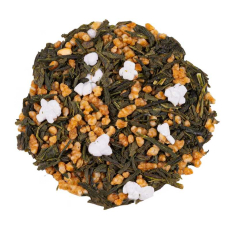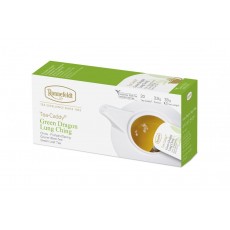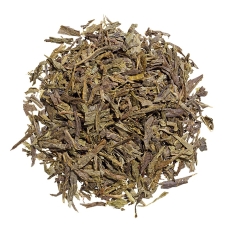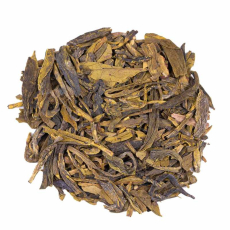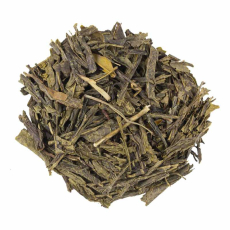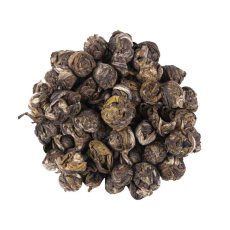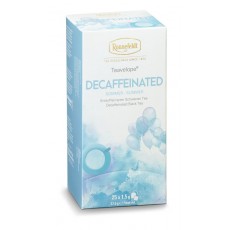Green Tea
Green Tea
Green Tea
Lung Ching Tea Bags
Green Tea
Green Tea
Organic
Green Tea
Green Tea
Green Tea
Organic
Green Teabags
Deli Pack
Flavoured Green Tea
Flavoured Green Tea
Flavoured Green Tea
Flavoured Green Tea
Flavoured Green Tea
Herbal Tea
Green Teabags
Deli Pack
Green Teabags
Deli Pack
Premium Pyramid Teabags
Cold Brew Tea
Green Tea
Flavoured Green Tea
Flavoured Green Tea
Green tea originated in China many thousands of years ago. It is believed that the Camelia Sinensis leaves were originally used for chewing, perhaps as a mouth freshener. The leaves were then used in cooking and were boiled in water and the people realised that the cooking water had a distinct and pleasant taste and would therefore drink the water. Green tea was born!
Green tea is distinctly different to black tea because it goes through a different process. Rather than being withered, rolled, fermented and dried, it is steamed or fired meaning the colour is much fairer and lighter.
Green tea gained its popularity as the Chinese tea ceremonies increased in the 8th century. The steaming method was practised and improved enabling the hosts to offer a far superior green tea at the ceremonies. As popularity grew over the coming centuries, green tea was not only offered at the tea ceremonies but became ingrained as part of everyday culture.
The finest of the tea leaves were offered to the emperors. These were known as tribute teas and it is the variety of tribute teas created during the early centuries that has offered us the luxury of such choices today.
Tribute teas initially began as a gift offered to emperors and royalty. As this gained kudos, only the best leaves were picked for such important aristocracy and the preparation and brewing methods were perfected. It was very competitive as it was the best way to win favour with important members of society. This practice soon started to be regulated by the Chinese government and laws were introduced to ensure high standards were met. Enormous imperial tea farms employing thousands of tea pickers were created in the best growing regions and there would be a flurry of activity during the early spring when the leaves were at their finest.
It was during this time that so much was learned about green tea. With every success story came another. As each imperial tea farm wanted to compete and out do the others, harvesting, steaming and brewing methods were adapted leading to a great variety of results. Loose tea followed tea bricks, tea was mixed with various other herbs and spices, scented tea became more popular and some teas would even be wrapped in the finest of silks to impress the emperors. It was in the 12th century that firing as a method of keeping the leaves green was introduced. Both firing and steaming methods continued to be used throughout history up until this day.
Green tea soon spread across Asia and is now produced and enjoyed all over the world. In fact, green tea has made somewhat of a comeback in the 20th/21st century as western countries have become more aware of its significant health benefits. Long live green tea!
Before deciding on your green tea it is important to know the difference between the varieties we offer. We have green teas from Japan, China and other growing areas like Taiwan. All come with their own distinct qualities and characters.
Green tea is created by preventing the freshly picked tea leaves from turning brown (oxidisation). In tea language we call this fermentation. To prevent fermentation the green leaves are rapidly heated soon after picking.
The main difference between Chinese and Japanese green tea comes from that heating process. Most Chinese teas are pan fired nowadays wheras Japanese leaves are immediately steamed. The main difference is that the firing method preferred in China leaves the tea with a softer and less grassy flavour and yellowy cup colour. Japanese teas tend to have a grassy taste and the cup colour can be bright green. One is not better than the other. It’s a matter of personal preference.
Immediately after being picked, green tea leaves are treated to stop the natural process of oxidisation. Japanese Green tea is steamed, while Chinese Green tea is traditionally pan roasted.The result is an unfermented tea that retains many of its naturally-occurring vitamins and minerals.
Matcha green tea is a Japanese tea and unlike other teas it is made from whole leaves which have been ground into a very fine powder. The powder is made from the same Camellia Sinensis plant as both Chinese and Japanese green teas. However, the leaves are immediately covered with cloths before being harvested. This ensures the growth of the best leaves. Some researchers suggest that Matcha may have more health benefits because the whole leaf itself is consumed rather than just the infused water. Matcha is a very versatile staple ingredient to have in your kitchen cupboard. It can be made into a traditional tea but it can also be mixed with fruit juice, milk, yoghurt and cooked in various recipes. What’s stopping you? Give it a go!
Try:
- Ronnefeldt Matcha Hikari Organic - This is a mild and fruity matcha, gentle, delicately tart, sweet and very digestible. Definitely a delightful experience for every matcha lover.
- Ronnefeldt Matcha Horai Organic - This is a mild and sweet matcha, soft and pleasant in taste. Definitely a delightful experience for every matcha lover.
- Ronnefeldt Matcha Premix - Matcha Premix - a sweet creamy mixture of Matcha with sugar for quick and easy delightfully delicious Matcha Cocktails.
With all teas you must remember that it is always best to use fresh spring or filtered water. Tap water can be too hard and can affect the subtle taste and aroma. Green teas taste best if brewed with water at around 80degC. It may be difficult to measure the temperature of the water but as a rule of thumb, boil some fresh water and leave the kettle to stand for 20 – 30 seconds before pouring the water over the tea leaves. Unlike brewing black teas, do not pre-warm the teapot and don’t use water that has been boiled many times either as this reduces the oxygen levels and flattens the water.
Brew the tea for 2 – 3 minutes for ideal results. Green teas can become very bitter if you over brew them or if you use too much tea.
Whether you are using a teapot or brewing in a cup or mug, always use a loose leaf infuser with plenty of room for the leaves to unfurl, move and release all of their flavour. If your infuser is too small the leaves will not be able to effectively release their flavours.
Chinese Green Tea
Chinese tea can often be infused more than one time which is wonderful if you like to top up your tea throughout the day. Brewing Chinese tea can be a very simple process and incredibly convenient. You don’t need any complicated equipment or specific knowledge. You can simply add the tea leaves to a cup or glass with a strainer and leave it for two to three minutes before drinking it. If you use a tall glass you can watch the tea leaves swirl around in the glass as the infusion takes place.
Japanese Green Tea
Tea has been celebrated in Japan for many centuries and this is a tradition that is very much alive today. The ceremony of tea drinking in Japan is one that must be understood to be appreciated. It is about humility, respect, appreciation and simplicity.
Each ceremony is a celebration of life and the moment that passes and the ceremony can vary depending on the time of year.
The most famous and most celebrated Japanese tea is Matcha tea (see below) but we also offer loose leaf green tea which must be tried to be appreciated.
Matcha Tea (Japanese Tea)
Matcha Green tea is the most unique of all of the teas because it comes in powder form and is the most traditional Japanese tea. Because it is a powdered leaf the whole leaf is consumed with every cup rather than the leaf being infused. Many people nowadays prefer this because of its associated health benefits and also because of the unique flavour created.
It is well worth investing in a good cup of Matcha by having the correct equipment and learning the preparation method well. Once you have the correct utensils and the know-how, you will enjoy every cup of Matcha tea and the ritual becomes part of the pleasure.
You will need a Matcha Bowl 0.4L, Bamboo Matcha Whisk, a bamboo Matcha scoop, a linen tea cloth, a seive, measuring cup and thermometer.
You need to start by preheating the bowl and the tip of the whisk. You then need to boil some water for the tea itself allowing this water to cool to approximately 70 degrees. Once the bowl is dried again, you can start to sift the tea into the bowl measuring it with the bamboo scoop, firstly with a small amount of water to make a paste and then add all of the water whisking the tea quite vigorously until you create a smooth frothy tea with tiny even air bubbles. There is no need to transfer the tea into a cup. Traditionally, all of the guests would drink from the same bowl.
Matcha has an intense grassy taste and is high in caffeine. It can be used in cooking and baking, and makes a delicious Matcha Latte with warm foamed milk.
Formosa (Taiwan) Green Tea
Formosa tea takes its name after the original name of Taiwan. In the world of tea, the island is better known for its Oolong teas but some very good traditional green teas are also produced there. It wasn’t until the 1600s that the Dutch introduced tea harvesting to Taiwan because of it being so well positioned between China and Europe. It had a slow start as a trade product because Taiwan relied more heavily on its sugar cane and rice however in the 1860s John Dodd started to promote worldwide awareness and appreciation of Formosa tea in order to compete with China and India. Tea is celebrated in Taiwan even to this day with tea being used to promote an awareness of harmony, the term being Cha Doa (the way of tea).
The general rule for brewing Formosa tea is the same as for other green teas. Add one heaped teaspoon per cup or mug to an infuser and allow the tea to infuse in 80C water for two to three minutes depending on personal preference. Ideally use a loose tea strainer but it is always best to ensure it is large enough to give the tea room to allow the water to come into contact with all of the leaves.





 EARN POINTS WITH OUR LOYALTY SCHEME
EARN POINTS WITH OUR LOYALTY SCHEME